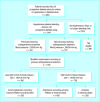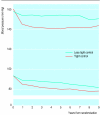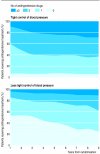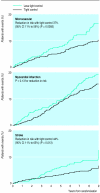Tight blood pressure control and risk of macrovascular and microvascular complications in type 2 diabetes: UKPDS 38. UK Prospective Diabetes Study Group
- PMID: 9732337
- PMCID: PMC28659
Tight blood pressure control and risk of macrovascular and microvascular complications in type 2 diabetes: UKPDS 38. UK Prospective Diabetes Study Group
Erratum in
- BMJ 1999 Jan 2;318(7175):29
Abstract
Objective: To determine whether tight control of blood pressure prevents macrovascular and microvascular complications in patients with type 2 diabetes.
Design: Randomised controlled trial comparing tight control of blood pressure aiming at a blood pressure of <150/85 mm Hg (with the use of an angiotensin converting enzyme inhibitor captopril or a beta blocker atenolol as main treatment) with less tight control aiming at a blood pressure of <180/105 mm Hg.
Setting: 20 hospital based clinics in England, Scotland, and Northern Ireland.
Subjects: 1148 hypertensive patients with type 2 diabetes (mean age 56, mean blood pressure at entry 160/94 mm Hg); 758 patients were allocated to tight control of blood pressure and 390 patients to less tight control with a median follow up of 8.4 years.
Main outcome measures: Predefined clinical end points, fatal and non-fatal, related to diabetes, deaths related to diabetes, and all cause mortality. Surrogate measures of microvascular disease included urinary albumin excretion and retinal photography.
Results: Mean blood pressure during follow up was significantly reduced in the group assigned tight blood pressure control (144/82 mm Hg) compared with the group assigned to less tight control (154/87 mm Hg) (P<0.0001). Reductions in risk in the group assigned to tight control compared with that assigned to less tight control were 24% in diabetes related end points (95% confidence interval 8% to 38%) (P=0.0046), 32% in deaths related to diabetes (6% to 51%) (P=0.019), 44% in strokes (11% to 65%) (P=0.013), and 37% in microvascular end points (11% to 56%) (P=0.0092), predominantly owing to a reduced risk of retinal photocoagulation. There was a non-significant reduction in all cause mortality. After nine years of follow up the group assigned to tight blood pressure control also had a 34% reduction in risk in the proportion of patients with deterioration of retinopathy by two steps (99% confidence interval 11% to 50%) (P=0.0004) and a 47% reduced risk (7% to 70%) (P=0.004) of deterioration in visual acuity by three lines of the early treatment of diabetic retinopathy study (ETDRS) chart. After nine years of follow up 29% of patients in the group assigned to tight control required three or more treatments to lower blood pressure to achieve target blood pressures.
Conclusion: Tight blood pressure control in patients with hypertension and type 2 diabetes achieves a clinically important reduction in the risk of deaths related to diabetes, complications related to diabetes, progression of diabetic retinopathy, and deterioration in visual acuity.
Figures









Comment in
-
Diabetes: a time for excitement-and concern. Hopeful signs exist that the ravages of diabetes can be tamed.BMJ. 1998 Sep 12;317(7160):691-2. doi: 10.1136/bmj.317.7160.691. BMJ. 1998. PMID: 9732333 Free PMC article. No abstract available.
-
Combined high blood pressure and glucose in type 2 diabetes: double jeopardy. British trial shows clear effects of treatment, especially blood pressure reduction.BMJ. 1998 Sep 12;317(7160):693-4. doi: 10.1136/bmj.317.7160.693. BMJ. 1998. PMID: 9732334 Free PMC article. No abstract available.
-
Treating type 2 diabetes. Study was conducted in exemplary fashion.BMJ. 1999 Mar 6;318(7184):666-7; author reply 668. doi: 10.1136/bmj.318.7184.666a. BMJ. 1999. PMID: 10066218 Free PMC article. No abstract available.
-
Treating type 2 diabetes. Difference needs to be explained.BMJ. 1999 Mar 6;318(7184):667; author reply 668. BMJ. 1999. PMID: 10215364 No abstract available.
-
Treating type 2 diabetes. Numbers needed to treat need to be clarified.BMJ. 1999 Mar 6;318(7184):667; author reply 668. BMJ. 1999. PMID: 10215365 No abstract available.
-
Treating type 2 diabetes. Important findings should not be published in two journals.BMJ. 1999 Mar 6;318(7184):667-8. BMJ. 1999. PMID: 10215366 No abstract available.
-
Type 2 diabetes is a major drain on resources.BMJ. 2000 Mar 18;320(7237):732. BMJ. 2000. PMID: 10720342 Free PMC article. No abstract available.
-
National screening programme for diabetic retinopathy. Screening by retinal photography offers holistic package of diabetic care.BMJ. 2002 Apr 6;324(7341):849; author reply 849-50. BMJ. 2002. PMID: 11936161 No abstract available.
References
-
- Garcia MJ, McNamara PM, Gordon T, Kannell WB. Morbidity and mortality in diabetics in the Framingham population. Sixteen year follow-up. Diabetes. 1974;23:105–111. - PubMed
-
- Stamler J, Vaccaro O, Neaton JD, Wentworth D. Diabetes, other risk factors, and 12 year cardiovascular mortality for men screened in the multiple risk factor intervention trial. Diabetes Care. 1993;16:434–444. - PubMed
-
- Manson JAE, Colditz GA, Stampfer MJ, Willett WC, Krolewski AS, Rosner B, et al. A prospective study of maturity-onset diabetes mellitus and risk of coronary heart disease and stroke in women. Arch Intern Med. 1991;151:1141–1147. - PubMed
-
- Perneger TV, Brancati FL, Whelton PK, Klag MJ. End-stage renal disease attributable to diabetes mellitus. Ann Intern Med. 1994;121:912–918. - PubMed
-
- Klag MJ, Whelton PK, Randall BL, Neaton JD, Brancati FL, Ford CE, et al. Blood pressure and end stage renal disease in men. N Engl J Med. 1996;334:13–18. - PubMed
Publication types
MeSH terms
Substances
Grants and funding
LinkOut - more resources
Full Text Sources
Other Literature Sources
Medical
